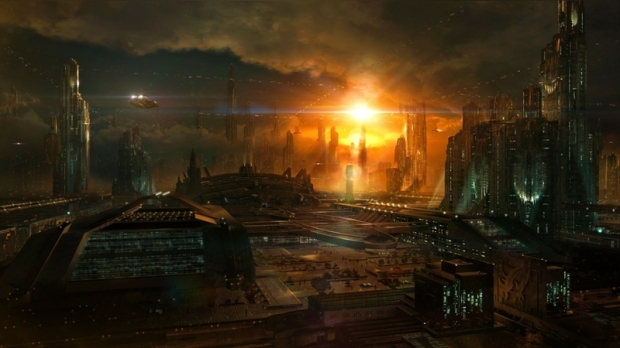Part Two of my Christian Sci-Fi Writing Primer. Have you read Part One?
This is a good time to discuss common science fiction technologies and the reasons they work. Don’t worry, I’ll keep the advanced physics to a minimum.
Faster than Light Travel (FTL)
A mainstay of much sci-fi, FTL is necessary due to the extreme distances involved in space travel. Though Einstein’s general theory of relativity does not allow for FTL travel within our universe, it has come to be a mainstay of science fiction. There are several accepted (i.e. commonly used) methods of achieving FTL travel.
Hyperspatial travel is based on either the multi-dimensional or multiversal theories of existence. Essentially, hyperspatial travel is achieved by moving the spacecraft to another dimension or parallel universe where the rules of physics as we know them no longer apply. In that other plane of existence, the spacecraft can go as fast as you want.
Wormhole travel presupposes that wormholes do, in fact, form an Einstein-Rosen bridge (a link between two distant points of spacetime) and that starships can survive a trip through a wormhole. This method adds interesting limits to the range and availability of FTL travel. Unless, that is, your civilization has the ability to create artificial wormholes a la Stargate.
Warp travel is based on the idea that spacetime can be manipulated, given a large enough power source. The essence of warp theory is that if space behind a ship is expanded while the space ahead of a ship is contracted, the ship will move without actually moving. Since spacetime, not the ship, is the thing moving, the ship could theoretically surpass the speed of light.
Time Travel
Time travel is considerably more difficult to justify than FTL travel, but that doesn’t stop authors from using it. While there are two theories which could possibly yield results, both relying on the creation of closed loops in time, there don’t seem to be any well-known or commonly accepted methods for time travel. (In my opinion, if you must have time travel, the safest route is to mostly ignore the mechanism whereby it is accomplished. Provide no details, and no one can say you were wrong.)
There are two schools of thought concerning time travel: the deterministic and the quantum mechanical. The deterministic school holds that even while traveling into the past, any changes you make have already happened. In essence, history cannot be changed by interference of any kind. On the other hand, the quantum mechanical school holds that history can be changed, often drastically, by even the smallest interference in the past.
These are obviously two extremes; most time travel in fiction falls somewhere between them in terms of what can and cannot affect history.
Shields
Shields are common to most space-travel science fiction, and serve all kinds of different purposes. Most shields are essentially curtains of energy which somehow reflect or absorb or otherwise neutralize weapons fire; in addition to containing atmosphere, keeping people in cells, or holding ships together.
Our modern understanding of physics doesn’t necessarily allow for shields along the lines of the ones featured in Star Trek or Star Wars (i.e. a simple curtain of energy), but something along those lines could possibly be developed. For instance, a curtain of energy projected and maintained by a series of units along a ship’s hull (or around the perimeter of a military base) could certainly provide a measure of defense against projectile weapons. At the same time, though, unless the field were operating on the same wavelength as an energy weapon directed at it, it would not serve to protect against energy weapons. For that, you would need an energy-absorbent, energy-diffusing, or energy-reflecting mesh (often created using nanoparticles of some kind).
Focused Energy Weapons
A staple of ship-to-ship warfare in sci-fi, focused energy weapons (whether called lasers, phasers, particle beams, or what have you) are in fact feasible. Lasers capable of cutting through metal and diamond have been built in laboratories here on Earth and are employed in various commercial applications.
All lasers function by sending a beam of light through an ‘active medium’ (which restricts the wavelength of the light), then focusing it by bouncing it back and forth between two mirrors, one of which is only partially reflective. Once the beam of light gathers enough energy, it can exit the partially reflective mirror.
The most important basics to remember with lasers are that in space, they don’t make any noise; they can be pulsed or continuous (but continuous lasers tend to be more efficient in terms of energy consumption); and they do require an enormous amount of power, so be sure to provide for that in the design of your ships.
Teleportation
Another staple of science fiction is the ability to move near-instantaneously between two points. Whether this is accomplished by transforming a person’s atoms into light and then re-encoding them as matter, by creating an artificial wormhole, or any other method; it is theoretically possible. A sufficiently large energy source coupled with an transmission system of incredible accuracy is necessary to pull it off accurately, though.
Those are the most important and ubiquitous technologies I can think of. There are, of course, others which are more obscure and I’m sure there are some you can dream up which haven’t been used yet. In the end, like everything else, the technology becomes yours; as an integral part of your writing, you should own it.
Remember to come back next week for Part Three of this series: Common Spiritual Pitfalls
